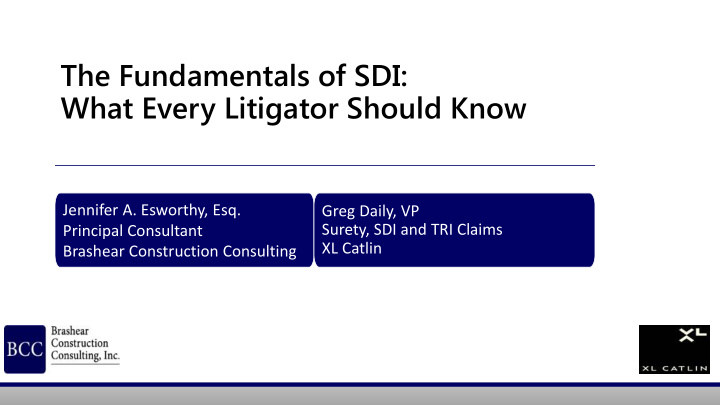



The Fundamentals of SDI: What Every Litigator Should Know Jennifer A. Esworthy, Esq. Greg Daily, VP Surety, SDI and TRI Claims Principal Consultant XL Catlin Brashear Construction Consulting
What is SDI? Subcontractor Established to default insurance is transfer risk in a first party similar manner to coverage. surety bonds “Indemnifies” for a loss. 2
Key Points for Construction Litigators Understand the What are my Subcontract and Is SDI at play? client’s rights key terms, esp How does SDI and obligations as it relates to a work? What is under the default of covered? policy? performance. 3
Similarities between Surety and SDI Protection from loss in the event of a default of performance. Both typically proceed under a reservation of rights, offsetting losses with the Available Subcontract Balance Must satisfy bond/policy conditions, ie proper default, timely notice, duty to mitigate. 4
Differences Between SDI and Surety SDI Surety • Two-Party Insurance Contract • Tri-Party relationship • Contractor to select means and • Surety typically controls means and methods. methods. • Contractor maintains control of • May encounter period of delay for completion schedule. investigation. • Reimbursement w/i 30 days of receipt of • Costs typically paid directly by the “satisfactory proof of loss”. Surety. • Limits of insurance likely exceed subk • Surety’s obligation limited to the penal price but large co-pay and deductible. sum (subcontract price). 5
The Insuring Agreement “Subject to the Limits of Insurance, we will indemnify you for a Loss after application of the Deductible and Co-Payment amounts [ sic ] and subject to the Retention but only to the extent of a Default of performance by your Subcontractor/Supplier as respects any Covered subcontract or purchase order agreement .” 6
Triggering Coverage The Parties : A Default of Named Insured and Performance: a Covered Was the Default Subcontract Proper? (enrolled sub) Satisfaction of Indemnification: policy conditions: Have the costs Notice been incurred? Co-Pay and Definition of “Loss” Deductible under the policy? Other Insurance Duty to mitigate 7
The Covered Subcontract • Verify that client is recognized as a named Insured under the Named Insured policy Enrollment • Verify that the Subcontractor (or Project) is enrolled. Valid Subcontract • Verify that there is an executed subcontract with defined terms. If unexecuted, consider other options, bid coverage. 8
The Default Default • Has the Sub failed to perform obligations under the subcontract? Notice • Has the Sub been placed on Notice of Default in accordance with the terms of the Subcontract? Defenses • Has the Subcontractor asserted any defenses? 9
Indemnification Loss • Understand how the policy defines “loss”, ie amounts paid due to the default of performance. Costs Incurred • Policy “indemnifies” Insured for amounts paid, must have exhausted Subcontract Balance. Payment • Payments can be made as soon as 30 days after receipt of a “satisfactory proof of loss”. 10
Satisfaction of Policy Terms and Conditions • Notice of Default /potential claim vs. submission of POL • Provide POL prior to: • Expiration of the Statute of Limitations Timely Notice • Expiration of right to seek recovery under the subcontract • 10 years after substantial completion. Deductible and Co-pay • Has Insured satisfied deductible and co-pays? Mitigate • Has Insured satisfied duty to Mitigate? 11
Covered Costs Labor (including staff labor Subcontractors (Cost of to supervise the defaulted completing the covered scope, hourly labor to Materials/Equipment subcontract and Cost of supplement and time for correcting defective work) claim preparation) Indirects (Acceleration, Legal and professional liquidated damages, Unpaid Vendors expenses extended general conditions) 12
Indirects Some policies include Understand how the policy Legal and Consulting Fees. defines “Indirect” costs. Typically includes delay related expenses: acceleration, extended Understand the sublimit general conditions and and impact if there’s liquidated damages. drawn out litigation. 13
Sample Claim Reconciliation Submitted Documented Original Subcontract $ 924,000 $ 924,000 Subject to policy terms, Change Orders $ 9,969 $ 9,969 Revised Subcontract $ 933,969 $ 933,969 an Insured may wish to submit costs while the Paid to Subcontractor $ (695,663) $ (695,663) Available Contract Balance $ 238,306 $ 238,306 work is ongoing. Interim reimbursement may be Additional Completion Costs Labor $ (15,011) $ (14,675) available to them. Material $ (1,300) $ (1,300) Equipment $ (18,099) $ (18,099) Subcontractors $ (443,972) $ (225,222) Legal/Professional $ (54,000) $ (15,754) Unpaid Vendors $ (21,598) $ (21,598) Indirects $ (65,243) $ - $ (380,917) $ (58,342) Sum 95% of sum if interim payment $ (55,425) 14
Exclusions What is an • Where a bond has been issued, with some exceptions “Excluded” • Fraud or misrepresentation • A subcontract acquired from another entity cost under • Arising from a material breach on the part of the Insured • Arising from acts of war, natural/nuclear disaster the terms of • Arising from professional services > 50% • Costs covered under other Insurance. the policy? 15
Other Collectible Insurance “This insurance shall be excess over any other Consider the impact of Other Collectible Insurance. valid bond or insurance Deductibles associated with other Insurance may be furnished to You by the covered. Subcontractor/Supplier. ” 16
Take Aways Representing GC’s Representing Subcontractors • Read the policy. • Read the policy. • Build a strong paper trail that tells the story. • Build the paper trail that tells the story. • Provide regular updates as to changes in • GC’s will control means and methods claim magnitude. to remedy default but Insurer may • Pursue multi directional strategy: pursue rights of subrogation. • Comply with notice provisions in subk and • Stay involved - watch costs and policy. consider impact of legal fees, • Watch waiver/ SOL issues. consultants and indirects/acceleration. • Develop Mitigation strategy. • Preserve defenses. • Look for Other Insurance. 17
Recent SDI Case Law • Waterscape Resort LLC v. McGovern , 2013 NY Slip Op 04709 (June 20, 2013). • Pavarani Constr. Co. v. Ace Am. Ins. Co., 15 U.S. Dist. LEXIS 22579 (2015). 18
Recommend
More recommend